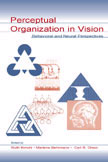Mid-level Vision
In contrast to low-level vision, which recovers information from the sensors, mid-level vision concerns how this information gets organized into what we experience as objects and surfaces. ("Mid-level vision" is nearly coextensive with what is called "perceptual organization.")
Contemporary research of mid-level vision draws upon the gestalt tradition in perception, which emerged in Austria in the late 19th century and came of age in Germany in the early 20th century. Following the demise of German science in the 1930s, the gestalt school virtually dissipated (but with some notable exceptions*). For several decades the literature on perceptual organization remained descriptive and amathematical, in the spirit of psychology of the early 20th century. Only recently this started to change. One of the new approaches was introduced by Michael Kubovy of the University of Virginia, who uses tools of mathematical psychology and modern methods of data modeling to discover the lawful structure of perceptual organization.
I joined Kubovy research group in 1997, when I came to the United States from Israel to study perceptual organization. In our joint work we sought to formulate mathematically tractable principles of perceptual organization concerning different perceptual dimensions:
-
We explored the conditions under which a collection of discrete elements behaves as a single entity -- a group -- in apparent motion. When this happens, the group of elements is seen to move in a direction different from the direction of any of its elements [1].
-
We looked into how space and time combine in perception of motion and found that perception of apparent motion cannot be reconciled with a simple (Euclidean or, more generally, Minkowski) metric of space-time. Our results showed that classical Korte's law of motion (space-time coupling) holds when speed of motion is high, but a qualitatively different regime of space-time combination (space-time tradeoff) holds when speed is low. We found that Korte's law and later evidence of apparent motion are special cases on a continuum, in agreement with the spatiotemporal sensitivity of low-level visual mechanisms [2].
- We studied interactions between successive processes of perceptual organization and measured the temporal contingencies between successive percepts that are usually described as adaptation and hysteresis. We found that the two effects add multiplicatively. It turns out, however, that the two effects can be explained using a single simple mechanism, in which an intrinsic random bias changes its properties slowly [3].
-
In static displays, we studied conditions under which contour fragments are perceived as continuous larger-scale contours. Our measurements showed that some curvatures of the resulting contours are preferred to other curvatures [4]. Next we examine whether this preference can be explained by the distribution of contour curvatures in the natural stimulation.
For a recent
review of our approach see [5].
Here are some details about this work. A complete list of publications is available here.
[1] Gepshtein, S. & Kubovy, M. (2000). The emergence of visual objects in space-time. Proceedings of the National Academy of Sciences, USA 97 (14) p. 8186-8191. [Reprint] [HTML]
 |
[2] Gepshtein, S. & Kubovy, M. (under review). The lawful perception of visual motion. [The manuscript is available on request. A short description of this work is available in the abstract and in the Power Point Slides of a talk given to the European Conference on Visual Perception, Paris, 2003.]
[3] Gepshtein, S. & Kubovy, M. (in press). Stability and change in perception: Spatial organization in temporal context. Experimental Brain Research. [Preprint]
[4] Kubovy, M. & Gepshtein, S. (2000). Higher curvature is preferred in the completion of visual contours. Investigative Ophthalmology and Vision Science 41 (4): 2322, B568. [Poster]
[5] Kubovy, M. & Gepshtein, S.(2003). Perceptual grouping in space and in space-time: An exercise in phenomenological psychophysics. In Behrmann, M., Kimchi, R. & Olson, C. R. (Eds.), Perceptual Organization in Vision: Behavioral and Neural Perspectives. Mahwah, NJ: Lawrence Erlbaum. pp. 45-85. [Preprint]
[6] Kubovy, M. & Gepshtein, S. (2000). Gestalt: from Phenomena to Laws. In: Perceptual Organization for Artificial Vision Systems. (Eds. Boyer, K. L. & Sarkar, S.) Kluwer Academic Publishers, Boston. p. 41-71. [Reprint]
This
article by Ken Nakayama provides some further details about mid-level
vision. (You need to subscribe to CogNet to view the linked page.)
[*] Cited above and highly recommended: Ash, M. G. (1995). Gestalt Psychology in German Culture, 1890-1967: Holism and the Quest for Objectivity, Cambridge University Press.